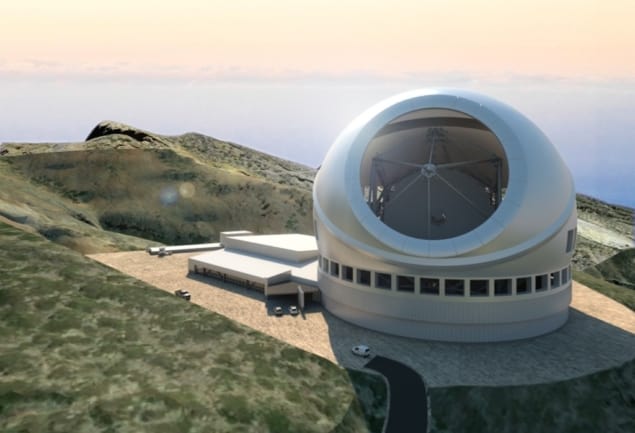
Officials at the Thirty Meter Telescope (TMT) have indicated they will seek a building permit to construct the giant telescope on the island of La Palma, belonging to Spain’s Canary Islands. While Mauna Kea in Hawaii remains the preferred site for the TMT, the continuing protests on the island are forcing officials to proceed with the legal requirements to build the observatory elsewhere.
Designed to have a primary mirror 30 m across made of 492 hexagonal segments enclosed in a structure 66 m wide and 56 m tall, when built the TMT will allow astronomers to resolve the faintest and oldest galaxies. The TMT board had chosen Mauna Kea, which already hosts 13 other telescopes, as the observatory’s site in July 2009. Since then, the organization has received a series of necessary approvals and permits (see timeline below).
Our position is that we are here if the TMT project needs us
Rafael Rebolo
However, native Hawaiians, who regard the Mauna Kea summit as sacred – and who had previously objected to the growth in the number of telescopes there – have protested against the telescope’s construction. Last month, when the TMT was again allowed to proceed towards construction, protesters blocked access roads to the mountain leading to arrests by police. Hawaii’s Department of Land and Natural Resources then granted a two-year extension to the deadline for starting construction, which is now set at 26 September 2021.
Support at ‘all levels’
Since 2016, the TMT Organisation has been studying alternative sites for the TMT should Mauna Kea not be a viable option and later that same year it selected the Observatorio del Roque de los Muchachos in La Palma as its preferred alternative site. In April 2018, TMT officials then postponed a final site decision to wait for “further progress in the legal process”.
Rafael Rebolo, director of the Canary Islands Astrophysics Institute, has told the Associated Press that he has received a letter from the head of the Thirty Meter Telescope project saying that its board has now decided “to proceed with the request to seek a building permit” for La Palma. “We are observing what is happening in Hawaii with the maximum respect,” Rebolo told AP. “Our position is that we are here if the TMT project needs us.”
In a statement yesterday, TMT executive director Ed Stone notes that Mauna Kea remains the “preferred site” for the TMT. “We continue to follow the process to allow for TMT to be constructed at the site in La Palma should it not be possible to build in Hawaii,” he says. “This process has been ongoing since 2016.”
Given that the project has the strong backing from government officials in Spain, the permit would face little resistance. Indeed, Spain’s science minister, Pedro Duque, last month issued his support. “We maintain the capacity and the goodwill of all the authorities and at all levels in the Spanish state so that if there is a decision to bring the telescope to the Canaries, [we] are all aligned in order to receive this telescope,” he stated on 30 July. “We have all the necessary plans at all levels, the people, the speed, the systems, absolutely everything is ready if they want to come.” Protest-hit Thirty Meter Telescope receives construction go-ahead in Hawaii
The possibility of relocating the TMT away from Mauna Kea has concerned some astronomers who think that La Palma’s environmental conditions will limit the telescope’s scientific potential. In particular, the warmer climate and lower elevation of La Palma compared to Mauna Kea will affect mid-infrared observations, which require dry, cool conditions. Such measurements are used, for example, to characterize nearby exoplanets and their atmospheres, and losing that ability would almost eradicate the exoplanet programme from the TMT’s science goals.
Yet, if the TMT is built at La Palma, then officials hope that the loss of sensitivity would be mitigated in part by adaptive optics and by carefully scheduling observations so that those requiring high infrared sensitivity can be on the clearest nights.
Timeline: ups and down of the Thirty Meter Telescope
2004 Project office for the $1bn Thirty Meter Telescope (TMT) is established
2007 The Gordon and Betty Moore Foundation pledges $200m to the TMT
2009 Mauna Kea in Hawaii is selected as the site for the TMT
2013 Hawaiian environmental officials give permission for the construction of the TMT
2014 Construction of the TMT begins following the approval of a sublease by the Hawaii Board of Land and Natural Resources (BLNR)
2015 Construction is halted after protests by native Hawaiians.
2016 Hawaii’s Supreme Court rules that the construction permit for the TMT is invalid while TMT officials choose the Canary Islands as an alternative site for the planned telescope if construction does not go ahead in Hawaii
2017 The BLNR grants a construction permit for the TMT following the recommendation by a senior judge
2018 Hawaii’s Supreme Court rules that construction of the TMT can begin
2019 Hawaii’s Department of Land and Natural Resources issues the TMT with a formal “notice to proceed”, but construction fails to begin following more protests. Officials grant a two-year extension to the deadline for starting construction.



